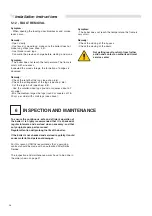
23
Installation instructions
5.2 - THE FIRE WOOD
The fire wood is formed mainly by lignite and
cellulose. It also contains other substances
such as resin (silver tree - pine), tannin (oak -
chestnut) and of course a lot of water.
Fire woods of very good quality are the oak, the
ash, the beech, the maple and the fruit trees,
except the cherry; of medium quality the
chestnut and the birch; of sufficient quality the
lime tree, the poplar and the willow. The resinous trees are,
normally, medium quality fuels.
The fire wood is then a fuel extremely heterogeneous, due
to different essences (beech, oak, fruit, resinous), different
humidity, different shape and dimensions.
The operation of the boiler will be certainly affected by all
these factors. Specially by the dimensions, the humidity
and how the fire wood is loaded in the boiler.
5.3 - THE WOOD HUMIDITY
The calorific value of different types of wood
depends on its moisture as indicated by the
table. Power and autonomy of the boiler will
decrease the moisture content increases. The
table shows the reduction factor of the power to
moisture of the wood used. The power output of
the boiler FOKOLUS is calculated with wood at
15% humidity.
As an example: a timber with 2 years of drying
the indoor humidity was 25%.
Example:
if the humidity of the wood used = 30%
effective rated= output power x 0.79
Correction factors for the humidity of the wood
% DI
UMIDITÀ
POTERE
CALORIFICO
kcal/kg
FATTORE DI
CORREZIONE
15
20
25
30
35
40
45
50
3.490
3.250
3.010
2.780
2.540
2.300
2.060
1.820
1
0,93
0,86
0,79
0,72
0,65
0,59
0,52
5.4 - WOOD LOGS DIMENSIONS
The wood log dimensions, combined with their
humidity, contribute to determine the output of
the boiler.
Small pieces (of length, however, conforming to the notes
given below) are more easily inflammable and therefore
they have the tendency to increase the boiler output and to
reduce, therefore, its autonomy.
Besides, they fall with greater facility, in the ash tray,
reducing the risk of formation of “bridges”. The so-called
“bridge” is an empty space in the firewood store, with
formations of wood bridges not burnt.
5.5 - CHECKS AT THE FIRST LIGHTING
GENERAL CHECKS
The first time:
- check that the system is full of water and
properly vented, the safety heat exchanger was
connected to the water supply via the thermal
discharge safety valve (fig. 6, page 14 and fig.
10 page 16),
- that the chimney has a sufficient draught,
- that the boiler pump and the recirculation
pump are not blocked (if any)
Also check that the cast iron grates are in
their places.
THE BY-PASS
The by-pass is a direct passage between the combustion
chamber and the chimney. It is normally closed by a
movable disk. When opening the wood loading door it is
previously necessary to open, manually, the by-pass.
The smokes accumulated in the combustion chamber can,
then, go directly to the chimney.
The by-pass, at the end, allows the smokes to reach
directly the chimney without escaping from the upper door
during the ignition operation and loading. However, it is
necessary to open the upper loading door slowly and
gradually to obtain an effective smoke suction by the
chimney draught.
CHEKING OF THE BY-PASS
When installing and before using the boiler it is necessary
to check the bypass for leaks and for its good operation.






































